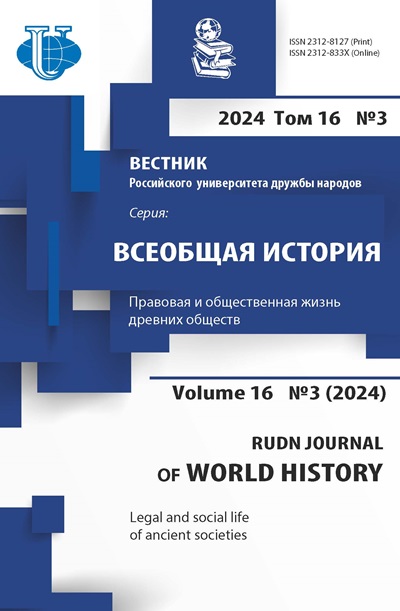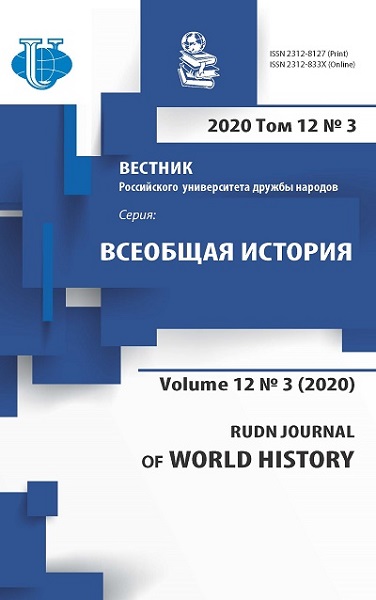Abbasid and Samanid military institutions as historical background for the Ghaznawids
- Authors: Minjia Y.1
-
Affiliations:
- Institute of Asian and African Studies (IAAS), Moscow State University (MSU)
- Issue: Vol 12, No 3 (2020)
- Pages: 250-260
- Section: Oriental Studies
- URL: https://journals.rudn.ru/world-history/article/view/24731
- DOI: https://doi.org/10.22363/2312-8127-2020-12-3-250-260
Cite item
Full Text
Abstract
Brilliant military achievements and fierce struggle between the sovereigns and his troops were characteristic of the Ghaznawid kingdom, the first Turkic dynasty in the history of Iran, while explanation of such paradox demands analysis of historical background for the Turkic rule. In view that one of the most important reasons for the decline of the Abbasids and the Samanids was the Turkic slaves’ arbitrary interference in the politics, the Abbasid and Samanid military institutions are researched in parallel. Scrutinize of narrative historical texts shows that the organization of armed forces under the two dynasties not only set an example for the Ghaznawids, but also prepared conditions for the Turkic ghulams’ rise to power, since originally the rulers of the two dynasties were forced to recruit them as reliance for the reign, while they were deprived of sovereignty with the strengthening of Turkic soldiers’ influence. Therefore, the Ghaznawids, maintaining the priority of the Turkiс component in the army, took precautions against the Turkic soldiers and generals.
Keywords
About the authors
Yan Minjia
Institute of Asian and African Studies (IAAS), Moscow State University (MSU)
Author for correspondence.
Email: katerina.chzhuana@yandex.ru
post-graduate student of the Department of Central Asia and the Caucasus of the Institute of Asian and African countries
11 Mohovaya st., Moscow, 125009, RussiaReferences
- Bayhaqī, Abū al-Fażl. Tā’rīkh-i Bayhaqī (“The History of Bayhaqi”), eds. ‘Alī Akbar Fayyāż& Muḥammad Ja‘far Yāḥaqī. Mashhad: Dānishgāh-i Firdawsī; 1383/2004. (In Pers.).
- Baikhaki. Istoriya Mas‘uda (1030–1041), tr. A.K. Arends. Moscow: Nauka; 1969. (In Russ.).
- Jurfādiqānī, Abu al-Sharaf Naṣikh. Tarjuma-yi Tā’rīkh-i Yamīnī (“Translation of the History of Yamin”), ed. Ja‘far Shu‘ār. Tehran: Bungāh-i Tarjuma va Nashr-i Kitāb; 1345/1966. (In Pers.).
- Manīnī, Aḥmad. al-Fatḥ al-Wahbī ‘ilā Tā’rīkh Abī Naṣr al-‘Utbī (“The bestowed conquest on the basis of Abu Nasr al-’Utbi’s History”). Cairo: [?]; 1286AH/1869-70. Vol. 2. (In Arab.).
- Islam. Ehntsiklopedicheskii slovar’ (“Islam. The Encyclopaedia”), eds. Miloslavskii GV et al. Moscow: Nauka; 1991. (In Russ.).
- Bartol’d VV. Turkestan v ehpokhu mongol’skogo nashestviya (“Turkistan down to the Mongol invasion”). In: Petrushevskii IP, editor. Akademik V.V. Bartol’d. Sochineniya (“Academic W. W. Bartol’d. Complete”), vol. 1. Moscow: Nauka: 45–761 (In Russ.).
- Bosworth CE. The Ghaznavids: Their Empire in Afghanistan and Eastern India 994–1040. New Delhi: Munshiram Manoharlal; 1992.
- Bosworth. Ghaznevid Military Organisation. Der Islam. 1960; 36 (1–2): 37–77. doi: 10.1515/islm.1960.36.1-2.37.
- al-Khwārazmī, Abū ‘Abd-allāh Muḥammad. Mafātīḥ al-‘Ulūm (“Keys to the Sciences”), ed. Muḥammad Kamal al-Din al-Adhamī. Cairo: [?]; 1349/1930. (In Arab.).
- al-Ṭabarī, Abū Ja‘far Muḥammad. Annales quos scripsit Abu Djafar Mohammed Ibn Djarir at-Tabari, eds. De Goeje et al., vol. 10. Leiden: Brill; 1897–1880. (In Arab.).
- al-Ṭabarī. Annales, vol. 11. Leiden: Brill; 1881. (In Arab.).
- al-Ṭabarī. Annales, vol. 12. Leiden: Brill; 1883–1884. (In Arab.).
- al-Ṭabarī. Annales, vol. 4. Leiden: Brill; 1890. (In Arab.).
- Nāẓim, Muḥammad. The Life and Times of Sulṭān Maḥmūd of Ghazna. Cambridge: Cambridge University Press; 1931.
- Hitti PK. History of the Arabs: From the Earliest Times to the Present. Hong Kong: M. Macmillan; 1970.
- al-Djahiz. Tria Opuscula auctore Abu Othman Amr Ibn Bahr al-Djahiz Basrensi, ed. G. van Vloten. Leiden: Brill; 1903. (In Arab.).
- Mottahedeh R. Loyalty and Leadership in an Early Islamic Society. Princeton: Princeton University Press; 1980.
- Barthold W, Spuler B. FARGHĀNĀ. In: Lewis B, Pellat Ch, Schacht J, editors. The Encyclopaedia of Islam [abbr.: EI], vol. 2. Leiden: Brill; 1991. Р. 790–793. doi: 10.1163/1573-3912_islam_SIM_2278.
- Kramers JH. USRŪSHANA. In: Bearman PJ, Bianquis Th, Bosworth, Donzel E, Heinrichs WP, editors. EI, vol. 10. Leiden: Brill; 2000. Р. 924–925. doi: 10.1163/1573-3912_islam_SIM_7752.
- Ibn Khordadbeh, Abu’l-Kasim Obaidallah ibn Abdallah. Kitab al-Masalik wa’l-Mamalik, ed. De Goeje. Leiden: Brill; 1889. (In Arab.).
- Tor DG. The Mamluks in the Military of the Pre-Seljuq Persianate Dynasties. Iran. 2008; 46 (1): 213–225. doi: 10.1080/05786967.2008.11864745.
- Bartol’d. Istoriko-geograficheskii obzor Irana (“An Historical-geographical overview of Iran”). In: Petrushevskii, editor. Akademik V.V. Bartol’d. Sochineniya, vol. 7. Moscow: Nauka; 1971: 31–227. (In Russ.).
- Talbi M. MAGHĀRIBA. In: Bosworth, Donzel, Lewis, Pellat, editors. EI, vol. 5. Leiden: Brill; 1986. p. 1159–1160. doi: 10.1163/1573-3912_islam_SIM_4761.
- al-Ṭabarī, Abū Ja‘far Muḥammad. The History of Al-Ṭabarī (Ta’rīkh al-rusul wa’l mulūk), vol. 33: The Caliphate of al-Mu‘taṣim (A.D. 833–842/A.H. 218–227), ed. & tr. Bosworth. New York: State University of New York; 1991.
- al-Mas‘udī. Muruj al-dhahab va ma‘ādin al-jawhar (“Meadows of Gold and Mines of Gems”), ed. Kamal Ḥasan Mar‘ī. Beirut: al-Maktabat al-‘asriyat; 1420/2005. Vol. 4. (In Arab.).
- al-Hamadhani, Ibn al-Fakih. Compendium Libri Kitab al-Boldan, ed. De Goeje. Leiden: Brill; 1885. (In Arab.).
- Ibn-el-Athiri. Chronicon quod Perfectissimum inscribitur: volume octavum, ed. Tornberg CJ. Leiden: Brill; 1862. (In Arab.).
- Treadwell WL. The Political History of the Sāmānid State [dissertation]. Oxford: University of Oxford; 1991. Available from: https://ora.ox.ac.uk/objects/ uuid:2bcb89ab-29b3-401b-84b9-e25c477476bb.
- Ibn Ḥauḳal. Opus Geographicum cui titulus est “Liber Imaginis Terrae”, ed. Kramers JH. Leiden: Brill; 1939. Fasc. 2. (In Arab.).
- Nizam al-Mulk. Siyar al-Muluk also known as Siyasat-nama, ed. Hubert Darke. Tehran: B.T.N.K.; 1968. (In Pers.).
- Ibn Isfandiyar, Muḥammad b. Ḥasan. Tā’rīkh-i Tabaristān (“The History of Tabaristan”), ed. ‘Abbās Iqbāl. Tehran: Majlis; 1320/1941. Vol. 1. (In Pers.).
- Gardīzī, Abū al-Sa‘īd ‘Abd al-Ḥayy b. Żaḥḥāk. Zayn al-Akhbār (“The Ornament of History”), ed. ‘Abd al-Ḥayy Ḥabībī. Tehran: Duniyā-yi Kitāb; 1363/1982. (In Pers.).
- Ibn al-Zubayr, al-Rashīd. Kitab al-Dhakhā’ir wa al-Tuḥaf (“The Book of Hoards and Rarities”), ed. Muḥammad Ḥamīdallah. Kuwait: Matba‘at Ḥukumat al-Kuwait; 1959. (In Arab.).
- Taeschner Fr. ‘AYYĀR. In: Gibb AR, Kramers, Lévi-provençal E, Schasht, editors. EI, vol. 1. Leiden: Brill; 1986. Р. 794. doi: 10.1163/1573-3912_islam_SIM_0927.
- Spuler. ČAGHĀNIYĀN. In: EI, vol. 2. Р. 1–2. doi: 10.1163/1573-3912_islam_COM_0132.
- Bosworth. KHWĀRAZM. In: Donzel, Lewis, Pellat, editors. EI, vol. 4. Leiden: Brill, 1997. p. 1060-1065. doi: 10.1163/1573-3912_islam_SIM_4205.
- Anonym. Ḥudūd al-‘Ālam min al-mashriq ‘ila-l-maqrib (“The Regions of the World from The East to the West”), ed. Manuchihr Sutūda. Tehran: Ṭahurī; 1983. (In Pers.).
- Narshakhī, Abu Bakr Mukhammad. Tā’rīkh-i Bukhārā (“The History of Bukhara”), eds. Abu Naṣr Aḥmad Alifbavī et al. Tehran: Tūs; 1363/1984. (In Pers.).
- Paul J. The State and the Military: The Samanid Case. Indiana: Bloomington; 1994.
- Golden PB. The Karakhanids and early Islam. In: Sinor D, editor. The Cambridge History of Early Inner Asia. Cambridge: Cambridge University Press; 1990. p. 343–370. doi: 10.1017/CHOL9780521243049.014.
- Novosel’tsev AP. Gosudarstva Samanidov i Gaznavidov (“The Samanid and Ghaznavid States”). In: Alaev LB, Ashrafyan KZ, editors. Istoriya vostoka (“History of the East”): vol. 2: Vostok v srednie veka (“The East in the Middle Ages”). Moscow: Vostochnaya literatura; 2002. (In Russ.).
- Bosworth. MUSHRIF 1: In the Arab and Persian lands. In: Bosworth, Donzel, Heinrichs, Pellat, editors. EI, vol 7. Leiden: Brill, 1993. p. 678–679. doi: 10.1163/1573-3912_islam_COM_0810.
- ‘Awfī, Muḥammad. Javāmi‘ al-Ḥikāyāt va lavāmi‘ al-rivāyyāt (“Collections of Stories and Illustrations of Histories”), ed. Amir-Bānū Karīmī. Tehran: Bungāh-i Farhang-i Īrān; 1359/1980-1. Vol. 2, fasc. 1. (In Pers.).













